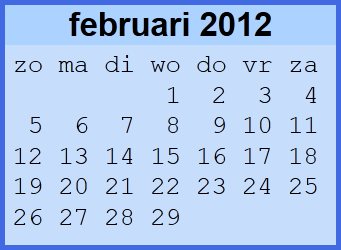Draw up a monthly calendar for a given month
in a given year. It is not allowed to use modules from The
Python Standard Library.
monthly calendar

The first line of the calendar is the English name of the month (written in lowercase letters), followed by a space and the year. The entire text should be centered and written over about 20 positions. The next line contains the consecutive weekdays, each shortened to two small letters, starting with Sunday and separated by spaces. Then follow all dates of the month on different lines, neatly aligned with the correct day on which these dates fall. The days are always right aligned and written over two positions, with a space between the different days as it was also used for the weekdays in the header. The output of the calendar contains no blank lines, and there are never spaces at the end of a line.
For a given day $$d$$, month $$m$$ and
year $$j$$ it can be calculated which weekday it is in the following way:
\[
\begin{array}{rcl}
j_0 & = & j - \frac{(14 - m)}{12} \\
x & = & j_0 + \frac{j_0}{4} - \frac{j_0}{100} +
\frac{j_0}{400} \\
m_0 & = & m + 12 \left(\frac{14 - m}{12}\right) - 2 \\
d_0 & = & (d + x + \frac{31m_0}{12})\!\!\!\mod 7
\end{array}
\]
All fractions represent divisions (quotient) and mod
is the modulo operator (remainder after integer division). Ultimately, the
value $$d_0$$ is the weekday, in which case the value 0 stands for Sunday, 1
for Monday, 2 for Tuesday, and so on.
When drawing up the calendar, remember that February has a different
number of days, depending on whether the specified year is a leap year or
not
Input
The first line of the input contains an
integer $$t$$ that indicates how many test cases there are. The next $$t$$
lines each contain two integers $$m$$ and $$j$$, which are separated by a
single space. These respectively represent the month $$m$$ and the year $$j$$
for which a calendar needs to be issued.
output
Output
For each test case a calendar must be drawn up for the month $$m$$ and the year $$j$$. A blank line should always be present between two consecutive calendars.
Example
Input:
3
2 2012
3 2012
2 2013Output:
february 2012
Su Mo Tu We Th Fr Sa
1 2 3 4
5 6 7 8 9 10 11
12 13 14 15 16 17 18
19 20 21 22 23 24 25
26 27 28 29
march 2012
Su Mo Tu We Th Fr Sa
1 2 3
4 5 6 7 8 9 10
11 12 13 14 15 16 17
18 19 20 21 22 23 24
25 26 27 28 29 30 31
february 2013
Su Mo Tu We Th Fr Sa
1 2
3 4 5 6 7 8 9
10 11 12 13 14 15 16
17 18 19 20 21 22 23
24 25 26 27 28